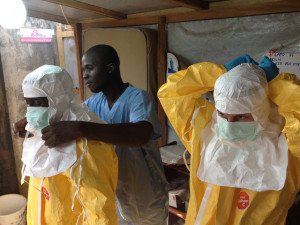Exactly a year ago, on 23 March 2014, the World Health Organisation (WHO) confirmed that there was a rapidly evolving outbreak of Ebola in Guinea.

Today, although the majority of cases are being brought under control, the disease is still affecting West African communities.
Other countries are also continuing to take extra precautions in diagnosing and caring for patients presenting with Ebola-like symptoms, including New Zealand.
You can read more about the past 12 months’ Ebola outbreak and progression in our previous posts.
Our colleagues at the UK SMC have collected expert commentary on the anniversary. Feel free to use these quotes in your reporting. If you would like to contact a New Zealand expert, please contact the SMC (04 499 5476; smc@sciencemediacentre.co.nz).
Dr Jake Dunning, Senior Clinical Researcher and Consultant in Infectious Diseases, University of Oxford, comments:
“The fact that the West African Ebola outbreak continues after so long illustrates just how serious an event this is. I still see families and communities devastated by this dreadful disease every day. The overall decrease in case numbers is encouraging, especially in Liberia, but West Africa needs to reach zero cases and then stay at zero.
“The recent local spikes in case numbers in Guinea and Sierra Leone are worrying and show that much still needs to be done. Existing public health measures alone may not be enough and without additional efforts, including an effective vaccine, the road to zero could be longer and bumpier than expected.
“For those who have Ebola virus disease, we need to offer more than supportive care to improve survival, and this is why the University of Oxford and others are continuing with trials of potential treatments, despite the immense challenges involved. Above all else, the global community must not forget West Africa. This is a dangerous time in the outbreak and many are battle-weary, but the affected countries and international partners must continue the fight together.”
Prof Trudie Lang, Director of the Global Health Network, University of Oxford, comments:
“This past year with Ebola has demonstrated acutely to the World what those of us working in this area have been struggling with for many years – that there are no proven treatments or practice for diseases like Ebola that occur in these outbreaks. The reason for this is that within these short windows it is incredibly difficult to conduct medical research to find out how best to care for these patients and to establish what could work as a treatment.
“Our team set out to find out whether we could prove if there is an effective treatment for Ebola and this involved setting up drug trials within the treatment centres in Liberia and Sierra Leone. Getting clinical trials underway is challenging in normal healthcare settings and working within the practical constraints and dangers of Ebola alongside working through the inevitable politics has made this a virtually impossible task. That said there has been an incredible international and highly collaborative effort to make this happen and we have a trial running smoothly in Sierra Leone which we hope can tell us whether this specific drug works. Then, once this has all calmed down there are important lessons to be learnt. There will be another Ebola outbreak, and other diseases will come along, and we must be prepared and ready to address the pressing questions that can teach us about these diseases and rapidly evaluate how to treat and care for those affected.”
Dr Derek Gatherer, Lecturer, Lancaster University, comments:
“Exactly one year ago, the WHO received laboratory confirmation that Ebola virus disease (EVD) had broken out in Guinea in December 2013. In retrospect, it is now apparent that the delay from December to March was crucial in the dissemination of the virus to several locations in eastern Guinea and then onto the capital, Conakry, which remains one of the few areas with active transmission. The lesson from this is that all clusters of haemorrhagic fever in tropical Africa, and indeed any non-haemorrhagic fever clusters with unusually high mortality rates, need to be addressed with all the urgency appropriate to a potential ebolavirus outbreak. This is not a trivial matter – with yellow fever, Lassa fever and cholera all common across the risk area, each of which has some symptoms that could be confused with EVD, the ebolavirus will always be the deadly needle in the immense haystack of tropical infections. However, the consequences of any failure to increase our state of EVD awareness may well be a repeat of the events of 2014. In parallel with the pressing clinical surveillance task of reacting faster to any potential EVD outbreak, we also have to understand more about the ecology of ebolaviruses in their animal hosts, such as bats, and the circumstances which lead to the periodic devastating transfer of EVD to humans. Again this is a dauntingly complex task – it remains questionable if there can really be any truly practical method of reducing the occasional ‘lightning strikes’ of EVD into human populations, but unless we look into the origins of those events, we’ll never know.”